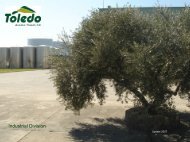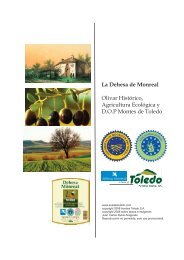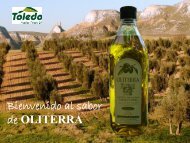On Olive Oil History and Facts. - Aceites Toledo SA
On Olive Oil History and Facts. - Aceites Toledo SA
On Olive Oil History and Facts. - Aceites Toledo SA
Create successful ePaper yourself
Turn your PDF publications into a flip-book with our unique Google optimized e-Paper software.
<strong>Olive</strong> <strong>Oil</strong> <strong>History</strong> <strong>and</strong> <strong>Facts</strong><br />
<strong>Olive</strong> <strong>Oil</strong> Constituents<br />
Page 3<br />
<strong>Olive</strong> oil is composed mainly of oleic acid <strong>and</strong> palmitic acid <strong>and</strong> other fatty acids, along with<br />
traces of squalene (up to 0.7%) <strong>and</strong> sterols (about 0.2% phytosterol <strong>and</strong> tocosterols ). <strong>Olive</strong> oil<br />
contains a group of related natural products with potent antioxidant properties which give extravirgin<br />
unprocessed olive oil its bitter <strong>and</strong> pungent taste <strong>and</strong> which are esters of tyrosol <strong>and</strong><br />
hydroxytyrosol, including oleocanthal <strong>and</strong> oleuropein.<br />
Spanish olive oil history<br />
Legend has it that once upon a time a dispute arose between the god Neptune <strong>and</strong> the goddess<br />
Minerva because of the power of Atica. Jupiter decided that he would give the power to whoever<br />
presented him the most useful gift for humanity. The dispute was resolved in favour of the<br />
goddess when she presented a branch asserting that it would become a strong tree, capable of<br />
living for centuries <strong>and</strong> centuries, <strong>and</strong> that not only would its fruits be good to eat, but<br />
furthermore, it would produce an extraordinary liquid that would serve to adorn the food of men,<br />
to alleviate their injuries, to give force to their bodies <strong>and</strong> light to their night.<br />
Homer called it "liquid gold." The olive tree, symbol of abundance, glory <strong>and</strong> peace, gave its leafy<br />
branches to crown the victorious in friendly games <strong>and</strong> bloody war, <strong>and</strong> the oil of its fruit has<br />
anointed the noblest of heads throughout history.<br />
Such was the importance of the <strong>Olive</strong> in the ancient World that <strong>Olive</strong> tree branches were placed<br />
in the tombs of the pharaohs of ancient Egypt, <strong>and</strong> as Andalucia was one of the most important<br />
olive oil production areas in the Roman Empire, an olive tree branch became the symbol of<br />
hispanic Rome.<br />
<strong>Olive</strong> <strong>Oil</strong> was also used by the ancient Hebrews. <strong>Olive</strong> oil of the highest purity was poured daily<br />
into seven cups of the golden c<strong>and</strong>elabrum, called the Menorah, in the holy temple of Jerusalem.<br />
<strong>Olive</strong> <strong>Oil</strong> was also used for the anointing the Kings of Israel <strong>and</strong> Judah. The word Christ ‘the<br />
anointed one’ is a literal translation of ‘Mashiach’, the Messiah.<br />
<strong>Olive</strong> cultivation began in the Middle East over 5,000 years ago <strong>and</strong> gradually spread westward<br />
throughout the Mediterranean basin. In Biblical times, it was used as a sanctifying chrism for<br />
kings, prophets <strong>and</strong> holy people from Samuel to Jesus. This practice continues to this day in<br />
some churches when people are anointed with holy oil. For the Greeks, olives <strong>and</strong> olive oil are<br />
not only important foods but also symbols of holiness, courage <strong>and</strong> life.<br />
Spain, not Italy, provided the bulk of the olive oil to the Roman Empire. Archeologists in Rome<br />
found a mountain composed of 40,000,000 earthenware vessels that bore the labels of to the<br />
Spanish producers in Andalucía. To this day Spain produces almost as much olive oil as the rest<br />
of the world combined. Today, two hundred sixty-two distinct varieties of olives are grown in<br />
Spain.<br />
As in classical times, Spain continues to be the world's leading producer of olive oil, with crops<br />
ranging the 1.000.000 tons per year. Over 250,000,000 olive trees grow in Spain covering 7,720<br />
square miles of groves that stretch as far as the eye can see. Some of them are over one<br />
thous<strong>and</strong> years old!









